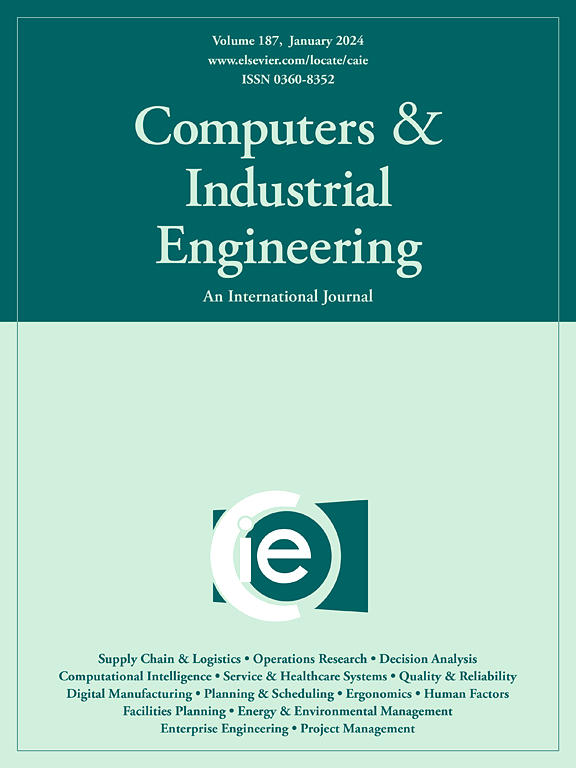Facility location and capacity planning for sampling and testing processes under demand uncertainty
IF 6.7
1区 工程技术
Q1 COMPUTER SCIENCE, INTERDISCIPLINARY APPLICATIONS
引用次数: 0
Abstract
During an outbreak, nucleic acid testing is essential for early infection detection and virus transmission control. In this study, we aim to location and capacity planning of testing facilities, balancing minimal costs with maximum population coverage during public health emergencies. We propose a novel two-stage robust optimization model that addresses uncertainties in sampling demand during an epidemic, with distinct phases for sampling and testing. Applying this model to medium and high-risk areas in Beijing during COVID-19, we use the column-and-constraint generation (C&CG) algorithm and compare its performance with three meta-heuristic algorithms: Differential Evolution (DE), Genetic Algorithm (GA), and Simulated Annealing (SA). Our findings reveal that the C&CG algorithm reduces sampling costs by 31.10% compared to DE, 26.77% to GA, and 21.17% to SA. It also lowers testing costs by 7.48%, 79.79%, and 60.63%, respectively, and achieves a higher completion rate for sampling and testing volumes, ranging from 93.12% to 100%. In addition, C&CG outperforms the other algorithms in handling large sample sizes by 43.98% to 61.84%. Despite its longer computational time, C&CG is more efficient in cost reduction and demand satisfaction. Furthermore, we analyze the impact of uncertainty set parameters, including a unified value of the demand risk parameter, and assess different cases. The corresponding location and capacity solutions can offer decision support for emergency agencies managing public health crises.
在需求不确定的情况下,取样和测试过程的设施位置和能力规划
在疫情期间,核酸检测对早期发现感染和控制病毒传播至关重要。在本研究中,我们的目标是在突发公共卫生事件中检测设施的位置和能力规划,平衡最小的成本和最大的人口覆盖率。我们提出了一种新的两阶段鲁棒优化模型,该模型解决了流行病期间采样需求的不确定性,具有不同的采样和测试阶段。将该模型应用于2019冠状病毒病期间北京的中高风险地区,我们使用列约束生成(C&;CG)算法,并将其与差分进化(DE)、遗传算法(GA)和模拟退火(SA)三种元启发式算法的性能进行比较。我们的研究结果表明,C&;CG算法比DE降低了31.10%的采样成本,比GA降低了26.77%,比SA降低了21.17%。检测成本分别降低了7.48%、79.79%和60.63%,采样和测试量的完成率从93.12%到100%不等。此外,C&;CG在处理大样本量方面的性能优于其他算法,分别为43.98%和61.84%。尽管计算时间较长,但C&;CG在降低成本和满足需求方面效率更高。此外,我们还分析了不确定性集合参数的影响,包括需求风险参数的统一值,并对不同情况进行了评估。相应的地点和能力解决方案可为管理公共卫生危机的应急机构提供决策支持。
本文章由计算机程序翻译,如有差异,请以英文原文为准。
求助全文
约1分钟内获得全文
求助全文
来源期刊

Computers & Industrial Engineering
工程技术-工程:工业
CiteScore
12.70
自引率
12.70%
发文量
794
审稿时长
10.6 months
期刊介绍:
Computers & Industrial Engineering (CAIE) is dedicated to researchers, educators, and practitioners in industrial engineering and related fields. Pioneering the integration of computers in research, education, and practice, industrial engineering has evolved to make computers and electronic communication integral to its domain. CAIE publishes original contributions focusing on the development of novel computerized methodologies to address industrial engineering problems. It also highlights the applications of these methodologies to issues within the broader industrial engineering and associated communities. The journal actively encourages submissions that push the boundaries of fundamental theories and concepts in industrial engineering techniques.
 求助内容:
求助内容: 应助结果提醒方式:
应助结果提醒方式:


